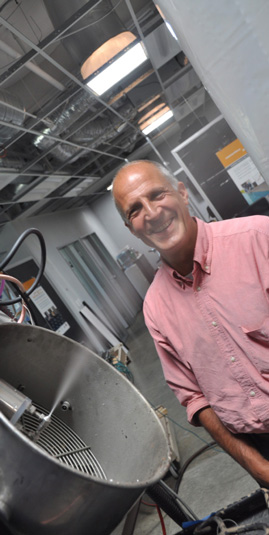While studying building ventilation systems in the 1980’s as a Staff Scientist, Mark Modera discovered that a great deal of heated and cooled air was escaping before it reached its destination, wasting billions of dollars and raising carbon emissions unnecessarily.
“I noticed that every time the air conditioner would kick on, the air change rate in the building would triple. I suspected that leaks in the ductwork were causing all that excess airflow,” said Modera, now director of the Western Cooling Efficiency Center at UC Davis, and a Professor in the Civil/Environmental and Mechanical/Aerospace Engineering departments.
For several years, Modera looked at a variety of solutions, including methods used to repair underground sewer pipes and small robots that repair gas lines. “The ‘Aha!’ moment came when I found a small company that sprayed an aerosolized product into a duct to kill dust mites,” he said.
Many iterations later, Aeroseal was born, and it’s commercial incarnation, “Aeroseal”, was just named one of the Top 100 Best New Products by This Old House magazine – and the No.1 product in the home technology category.
Aeroseal was chosen because of its proven impact on home energy savings and comfort, said Thomas Baker, the magazine’s building technology editor. “I’ve been watching the development of the Aeroseal technology and eagerly awaiting its general availability,” he said. “Leaky air ducts are responsible for a huge energy loss problem in America, and having the Aeroseal solution made available for the first time to many home owners is very exciting to see.” (Read more)
How Aeroseal works
Aeroseal quickly repairs almost 100% of leaks in ducts that are otherwise inaccessible without significant building renovation. The installation begins with pressurizing the duct network with a calibrated-flow fan. Once the ducts are pressurized, the technician injects a suspended aerosolized adhesive that moves only where the momentum of aerosol particles accelerates through leaks in the ducts. This system works with such precision that the interior duct walls do not get needlessly coated with adhesive. The adhesive nucleates on the edges of a leak and builds a seal that blocks air flow.
The result is a fast, non-invasive method to seal inefficient air ducts, helping reduce energy costs due to over-burdened air-handlers and infiltration of unwanted hot or cool air into the ducts and the building.
The Future of Aerosol Based Sealing
Today, the UC Davis Western Cooling Efficiency Center, under Mark Modera’s direction, is researching other vital uses for aerosol-based sealant applications similar to Aeroseal.
“Using the concept of aerosol particles has a lot of other potential applications, such as sealing building envelopes and other components, shipping containers and even underground pipelines,” says Modera.
Initial tests of aerosol sealants in building envelopes were limited to small-scale testing with an 8-foot-tall box just to see if aerosol particles could do the sealing and how long it would take to seal leaks in a large open environment. “The box leaks actually sealed much faster than we anticipated,” says Curtis Harrington, the Western Cooling Efficiency Center lead engineer on the project “It only took about 5 minutes to fully seal the enclosure with a total of 41 square inches of leak area.”
Harrington said tests on an actual building envelope are planned soon. “We are working with CONSOL (a building energy consulting firm in Stockton) and Habitat for Humanity to test the process in a home before the end of the year.”

Energy Dept. features Aeroseal
Here’s how the U.S. Energy Department describes Aeroseal on its website:
Who knew air leaks could be costing Americans $5 billion every year? Typical air duct systems, both residential and commercial, typically lose 25-40 percent of heating and cooling energy, accounting for billions added to utility bills.
But what if there was a simple mist that could seal thousands of leaks in 4 to 8 hours, saving a home owner, on average, $600 to $850 a year on his or her heating and cooling costs?
Thanks to a breakthrough technology developed at the Energy Department’s Lawrence Berkeley National Lab, such technology exists. Aeroseal LLC, a start-up that licensed the technology, has now made the technology available to thousands of home owners and business owners concerned with high utility bills and sustainable living.

“Using the concept of aerosol particles has a lot of other potential applications, such as sealing building envelopes and other components, shipping containers and even underground pipelines.”
—Mark Modera,
WCEC Director
WCEC Researchers & Engineers
Mark Modera
Curtis Harrington
Written By
Paul Fortunato & Sylvia Wright

